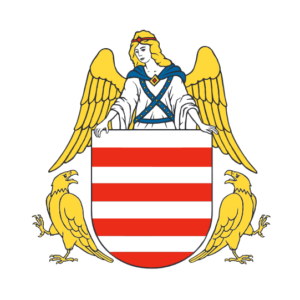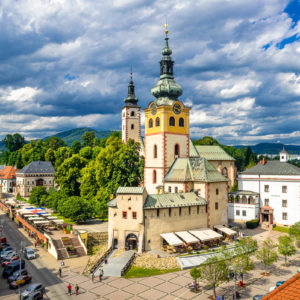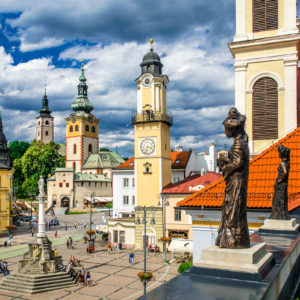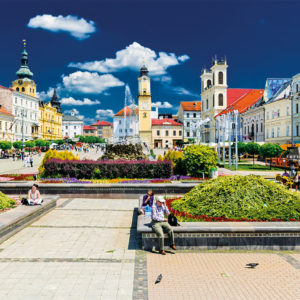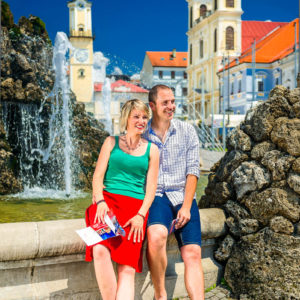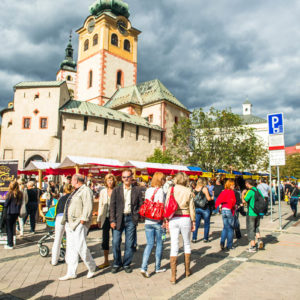EN
About Banská Bystrica
Banská Bystrica is considered to be the heart of Slovakia. It is surrounded by mountain ranges with national parks. Banská Bystrica is a significant transportation node in terms of tourism development. It is accessible by all means of transportation – car, bus, train and as well air service through nearby Sliač airport situated only 15 km away (closed to all civilian traffic), other airports in: Bratislava, Košice, Žilina, Poprad.
The city has a rich history
The first written record dates to the 13th century. In 1255 king Belo IV promoted the status of the original Slovak settlement of Bystrica to that of a free royal city. After 1380 Banská Bystrica became a leader in a union of mining towns. At the beginning, gold and silver were mined here, but from the 14-th century it was especially copper, quicksilver and lead. After economic decline in the 15-th century the Thurzo-Fugger Company renewed the mining industry and exported copper to the Western European market. In the 16-th century crafts and trade activities gained on importance. The first manufactures arose in the 18-th century. In the second half of the 19-th century they transformed into industrial factories that produced textile, blueprint, manufactured wood, cereals, beer and spirit. A significant feature of the city is its rectangular square with historical houses, a Virgin Mary column and a unique clock tower.
The oldest part of Banská Bystrica is town castle Barbican at the edge of SNP Square. It is enclosed within what has remained of its original fortifications − a barbican protecting the main gate, three bastions, and part of the walls. In the centre, there is a Roman-Catholic church of Holy Mary, originally built in the Roman style in the 13-th century. It was rebuilt in the 14-th, 15-th and 16-th century. After it burned up in 1761 its interior gained late-baroque appearance. In the church, there is a precious side-altar of St. Barbora from Master Paul from Levoča, a gothic stone baptistery, a stone relief and side-altars of Maria Magdalena from the end of the 15-th century. Historical expositions are situated in Thurzo´s house, in the house of Dominik Skutecký and in The State Gallery. In the centre of the city is Square of Slovak National Uprising (Námestie SNP).
Other precious monuments in the city are: Matej´s House, Mining bastion, Slovak church, Parish bastion, Church of St. Elisabeth, Town-Hall, gothic and renaissance townsmen houses (Thurzo´s house, Benický´s house).
During the World War II. on August 29, 1944, partisans liberated Banská Bystrica from the German occupation and the city became the centre of the Slovak National Uprising. The Slovak Army and guerrilla troops had the seat here and a guerrilla broadcaster transmitted from the city. Along with the Warsaw Uprising, it was the largest uprising against Nazism and its allies in Europe. The German Army occupied the city since October 27, 1944. Banská Bystrica was liberated by Soviet and Romanian troops on 26 March 1945. After the war, Banská Bystrica became the administrative, economic, and cultural hub of central Slovakia. Banská Bystrica was proclaimed as a city monument reservation, among the first in Slovakia.
Modern history
Upon creation of the Slovak Republic in 1993, the city sought to strengthen its historical disciplines – banking, education, tourism and top sports. With the founding of Matej Bel University in 1992, Banská Bystrica became one of the centres of university education in Slovakia. Currently, Banská Bystrica is an economic, administrative and cultural centre of Central Slovakia, and a home to the Banská Bystrica Self-Governing Region.
Number of Inhabitants
According to data from the registry, 73040 inhabitants had their permanent residency in the city at the end of 2024, thus ranking Banská Bystrica as 6th largest by population in Slovakia. In terms of level of education, a large percentage of inhabitants are university graduates, which offers a good foundation for further city development. Because Banská Bystrica lacks a strong industrial base the focus is on development of tourism, support for both professional and amateur sports and education.
Competence
The City of Banská Bystrica was established on 1.1.1991 according to law No. 369/1990 Col. about municipal constitution. Banská Bystrica is independent autonomous territorial body of Slovak Republic, uniting it´s own permanent residents.The city decides independently and acts on it´s own behalf in matters connected with municipal administration and town property, if there´s no special law commending this tasks to the state or another legal body.The performance of municipal administration is done by autonomous representative bodies – the Mayor and the City Parliament. The City Parliament can establish other bodies and give them occupation – Board of Representatives, special committees, City Police and other temporary or control bodies.
Schools in Banská Bystrica
The city is a place of 3 universities – University of Matej Bel (6 Faculties) with nearly 8 000 students and university campus, Academy of Art (3 Faculties) with approx. 600 students, The Faculty of Health of the Slovak Medical University in Bratislava which provides education in accredited fields of study, for example Physiotherapy, Urgent Health Care. Banská Bystrica has 18 high schools where among them is very popular Sport High Scholl with long tradition and outstanding results. The school has 405 students enrolled in 19 sports. 23 elementary schools administered by the city. As to the sport activities, one of them is the most significant – Elementary school, Golianova str. where sports classes were established in 1968. School has very modern athletic and sports area and gym.
Banská Bystrica – the European City of Sport 2017
Banská Bystrica gained the title of 2017 European City of Sport, awarded by ACES Europe and accepted by Mayor of city in Brussels on December 2016. Sports activities carried out in Banská Bystrica lifted this positive attitude towards sports to previously unseen numbers. Using our ECS Ambassadors, excellent athletes, Olympians, world and European champions, we kept luring thousands of inhabitants to sport.
Almost every year 22 174 of registered sportsmen are involved in sport competitions on local, regional and international levels. 37 276 inhabitants of Banská Bystrica registered for events of recreational sport and sport for handicapped communities. The entire number of those recorded for a sport activity in Banská Bystrica is 59 450 persons, i.e. 77.20% of the town population. These numbers prove how important and vital is to have the project of European city of sport, with Banská Bystrica being the prime example of this. It is due to support of municipality and partners.
European Youth Olympic Festival 2022
The XVI Summer European Youth Olympic Festival (EYOF) was held in Banská Bystrica, Slovakia from 24 to 30 July 2022. EYOF is the first top European multi-sport event aimed at young athletes aged 14 to 18. There is a winter and a summer edition, which take place in two-year cycles, in odd-numbered years. The event takes place under the Olympic flag, and is rich with Olympic traditions: from the burning flame to athletes’ and officials’ oaths. The EYOF is a gateway to the Olympic Games, with many medallists having gone on to win medals at an Olympic Games. It is at the EYOF that many of Europe’s inspiring sports stars of tomorrow take their first steps on the international stage. And while some may enjoy EYOF as a stepping-stone to Olympic greatness, all who participate take home friendships and experiences to last a lifetime. EYOF gives top young athletes a first taste of what an Olympic event is like, at the same time encouraging more youngsters to practise sport and lead a healthy lifestyle. EYOF is held under the patronage of the International Olympic Committee (IOC).
European Athletics U18 Championships 2024
The fourth edition of the European Athletics U18 Championships was held in Banská Bystrica from 18-21 July 2024. The European Athletics U18 Championships is a biennial competition for European athletes under the age of 18 in the year of competition.
History of Sport in Banská Bystrica
The history of sports began in the year 1889 and in 1900 was established the first sports club, BSC (Beszterszbányia Sport Club), with cycling, tennis and football units. In 1919 was created one of the largest sports clubs in Slovakia, Slávia Banská Bystrica. As the site for summer and winter sports, Banská Bystrica earned its nickname “Slovak Davos” in 1930s.1962 – Foundation of University Physical Exercise Training Club, Slávia Pedagogic Institute. 1965 – Foundation of an army sports centre that housed football, track and field, ski-jump, judo, sports gymnastics, water polo, biathlon, fencing, modern pentathlon, sports shooting, swimming, water slalom and downhill skiing. Currently it operates as the Army Sports Centre Dukla Banská Bystrica (VŠC Dukla). In 1979 was founded the first sports boarding school, the first one in Czechoslovakia. The Sport high school produced several World and European champions and Olympic sportsmen. In 1992 foundation of Matej Bel University, UMB Sports Club. Currently the club has more than 1,000 active members in 10 sport disciplines.
Weather conditions
In Banská Bystrica, Zvolen and their region, the summers are comfortable, the winters are freezing and dry, and it is partly cloudy year-round. Over the course of the year, the temperature typically varies from -6°C to 25°C and is rarely below 16°C or above 33°C. Based on the tourism score, the best time of year to visit Banská Bystrica for warm-weather activities is from mid-June to late August.
Coordinates: 48°44′07″N 19°08′43″E Google maps
Country: Slovak Republic (Slovakia)
Region: Banská Bystrica
District: Banská Bystrica
Historical names of Banská Bystrica: Neosolium (Latin), Neusohl (German), Besztercebánya (Hungarian)
Population (2024): 73,040 inhabitants
Area (Total): 103.37 km2 (39.91sq mi)
Elevation: 368 m (1,207 ft)
Urpín (mountain in the city), elevation: 510 m (1,673 ft)
Hron – The Hron River curves through the city from the east to the south.
Barbakán – The oldest part of Banská Bystrica is City Castle Barbican at the edge of SNP Square.
Námestie SNP – SNP Square is the natural center of the city (main square). The square is named after the Slovak National Uprising.
Time zone: UTC+1 (CET) , Summer (DST) UTC+2 (CEST)
Postal code: 974 01
Country calling code (Slovakia): +421
City calling code for Banská Bystrica: 048
City Police (nonstop call number): 159
Police (State) nonstop call number: 158
Emergency (Integrated Rescue System telephone number): 112
Hospital (FNsP FDR): www.fnspfdr.sk
Public transport and lines (MHD): www.imhd.sk
Transport Connection search: www.cp.sk
Discover Banská Bystrica: www.visitbanskabystrica.sk
Thurzo – Fugger Experience Exposure (Barbican Castle): www.tfze.sk
SmartGuide audio guide app: www.smart-guide.org
European Fugger Road: fuggerstrasse.eu
Barborská cesta (Barbara’s Way): www.minesb.eu
Matej Bel University (UMB): www.umb.sk
Banská Bystrica Self-Governing Region (BBSK): www.bbsk.sk
Free WiFi, SSID: SmartBanskaBystrica, WiFi4EU, …
Currency: Euro €

